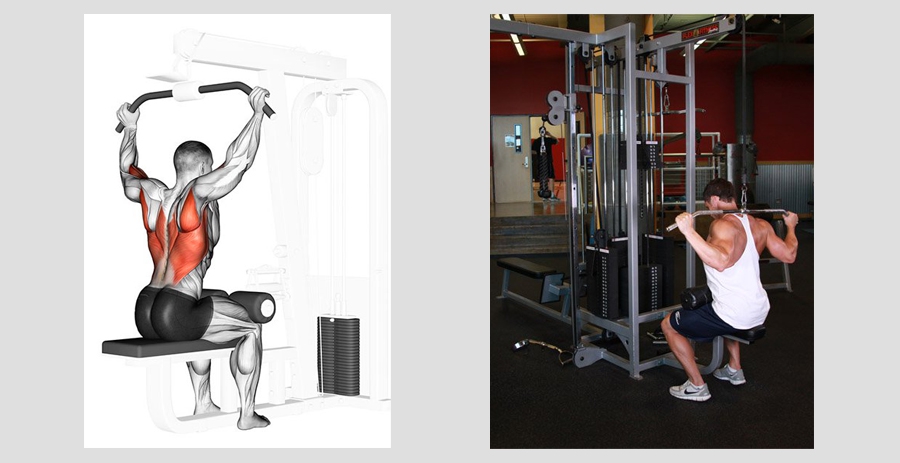The overhead pull is one of the popular exercises for developing the broadest muscles of the back on machines..
In terms of movement mechanics, the upper block pull behind the head mimics a classic pull-up on the bar.
Beginning lifters should pay attention to the rhythm of breathing and choose an adequate level of exertion when performing the upper pulley pull. Setting the correct technique will be the foundation for your development as an athlete.
Using
In bodybuilding the pulling is used as an overhead pull to strengthen the latitude muscles, and in powerlifting as an auxiliary exercise to work the upper back and improve your strength criteria. The head-over-heels pull is also an upper-body strength booster that can be incorporated as an additional exercise in a lifter's basic routine.
Benefits
Properly performed and systematic training will significantly increase the strength of your back and muscle definition. This can be seen by forming a V-shaped torso and increasing the width of the back. The body will have a straighter posture.
Muscles at work
The main load during the exercise is on the broadest muscles of the back. In addition, the rear delts, biceps, lower trapezius and rhomboidal muscles are involved. This exercise also works the upper body muscles with varying degrees of intensity. This distribution of the load stimulates the growth of the working upper body muscles.
Techniques for performing the upper block pull behind the head
Correct technique of upper block exercises and basic knowledge of biomechanics exclude potentially dangerous situations and increase efficiency of pumping muscles of the back and upper part of the body.
Let`s look at the step-by-step performing of upper block pull behind the head
Not a big warm-up. Before doing the exercise, you must prepare the muscles to intensive work. Stretch the neck, joints of the shoulder girdle and arms. First work with minimum weight in warm-up phase.
Take into account the initial position of the body. Control the correct body position on the exerciser. Use the platens to stabilize your legs. Maintain a straight posture with a natural contour of the back. Shift the body slightly forward. Roll your eyes in front of your body. Slightly lower the shoulders. Use a wide grip on the bar from above. Approximate grip width in relation to shoulders is 1.5.
Control breathing and movement amplitude. While exhaling pull the block down and behind the neck. As you touch the neck, bring the shoulder blades together and fix static body position for 1-2 seconds. As you inhale smoothly, without any sudden movements straighten the arms and return to the starting position.
Number of reps is classic for the multi-repetition training mode, 8-12 times. In 3 to 4 sets.
Features
Pay attention to the position of the body at the lowest point of the bar path - when touching the upper third of the neck. There should be no excessive forward movement of the body. The rhythm of the movement is measured and clear. Powerful movement of the block downwards and behind the neck, and a smooth return upwards.
Elbows must be in line with the body when moving down. Do not straighten arms fully when returning the block. Maintain a static load.
Errors
Most often, beginners use an overly wide grip on the bar and adopt an incorrect starting position at the beginning of the exercise, followed by a locking position. Lack of a basic warm-up increases the potential risk of injury to the shoulder girdle muscles. Separately, we should mention the most common mistake made by beginners - finishing the pull with the arm muscles. This is how athletes try to cope with excess weight, thus reducing the load on the broad muscles.
Conclusions
The overhead pull is a popular and effective exercise on the trainer and is a good addition for training the broadest muscles. Perform it after basic exercises with free weights and do not rush to increase the load.
Remember the principle of 'hurry up slowly' and you will achieve the desired results both in strength performance of the back and in the relief of its muscle atlas.
Questions about pulling a block behind the head
How to do it correctly?
Use step-by-step technique and control amplitude and breathing
What are the benefits of the upper block pull behind the head?
Development of back and upper body
What equipment do I need?
Classic trainer with overhead block and wide handle for pulling.



